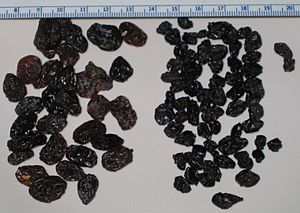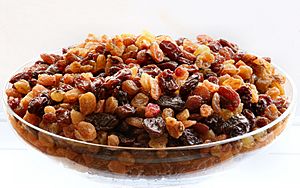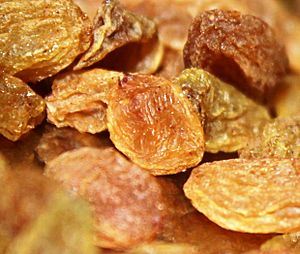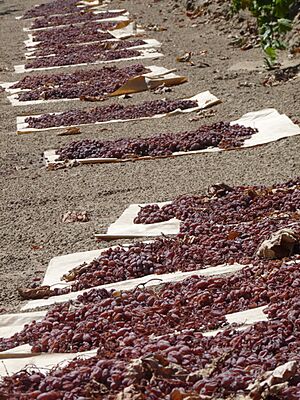Raisin facts for kids
A raisin is simply a dried grape. People around the world enjoy raisins as a snack or use them in cooking, baking, and even making drinks. In some countries like the United Kingdom, Ireland, Australia, and South Africa, the word "raisin" usually means a dark, large dried grape. Lighter, golden-colored dried grapes are often called sultanas, and very small, dark, seedless dried grapes are known as currants.
Contents
Types of Raisins: Colors and Flavors

Raisins come in many different types, depending on the grapes they are made from. You can find them in various sizes and colors, including green, black, brown, purple, blue, and yellow. Some popular types are seedless, meaning they don't have seeds inside. These include sultanas, which are often made from Thompson Seedless grapes in the United States. Other seedless types are Zante currants and Flame grapes.
Traditionally, raisins are made by letting grapes dry in the sun. However, they can also be dried using special machines. Golden raisins get their bright color from a special treatment with sulfur dioxide before drying, instead of just sun-drying. Sometimes, these are dried in machines with controlled temperature and moisture. This helps them stay a bit softer.
Black Corinth or Zante currants are small, dark raisins. They have a unique tart and tangy taste. These are often just called "currants." Muscat raisins are known for being larger and sweeter than other kinds. In the Middle East and Asia, large black monukka grapes are used to make big raisins.
How Raisins Are Made: From Grape to Snack
Making raisins involves a few important steps. First, grapes are harvested. Then, the water inside the grapes needs to be removed. This process can be tricky because grape skins have a waxy coating that stops water from easily escaping. Also, grapes have natural ways to prevent water loss. The main steps are pre-treatment, drying, and post-drying.
Preparing the Grapes for Drying
Pre-treatment is a key step to help the grapes dry faster. When grapes dry quickly, they look better and taste better. Historically, people in the Mediterranean and Asia Minor used a special cold dip made from potassium carbonate and other natural ingredients. This dip helped water leave the grapes two to three times faster.
Today, new methods include dipping grapes in oil mixtures or mild alkaline solutions. These methods help water move to the surface of the grapes. This makes the drying process much more efficient.
Drying Methods: Sun, Shade, and Machines
There are three main ways to dry grapes into raisins. The first is sun drying, which is a very old and inexpensive method. However, sun-drying can expose grapes to dirt, insects, or unwanted microbes.
Another method is shade drying, where grapes dry in shaded areas. Mechanical drying uses machines in a controlled environment. This method is safer and ensures faster drying. One type of mechanical drying uses microwave energy. The water inside the grapes absorbs the microwaves, causing it to evaporate quickly. This can make the raisins a bit puffed up.
Finishing Touches: Cleaning and Packing
After the grapes are dried, they go to processing plants. Here, they are cleaned with water to remove any dirt or small pieces that might have stuck to them during drying. Stems and any raisins that aren't perfect are also removed. Sometimes, washing can make the raisins a bit wet again. So, they go through another quick drying step to remove any extra moisture.
Every step in making raisins is important for their quality. Sometimes, after pre-treatment but before drying, a small amount of sulfur dioxide is used. This helps prevent the raisins from turning brown. It also helps keep their flavor fresh and protects some vitamins during the drying process.
| Nutritional value per 100 g (3.5 oz) | |
|---|---|
| Energy | 299 kcal (1,250 kJ) |
|
79.3 g
|
|
| Sugars | 65.2 g |
| Dietary fiber | 4.5 g |
|
0.25 g
|
|
|
Protein
|
3.3 g
|
| Vitamins | Quantity
%DV†
|
| Thiamine (B1) |
9%
0.106 mg |
| Riboflavin (B2) |
10%
0.125 mg |
| Niacin (B3) |
5%
0.766 mg |
| Pantothenic acid (B5) |
2%
0.095 mg |
| Vitamin B6 |
13%
0.174 mg |
| Folate (B9) |
1%
5 μg |
| Choline |
2%
11.1 mg |
| Vitamin C |
3%
2.3 mg |
| Vitamin E |
1%
0.12 mg |
| Vitamin K |
3%
3.5 μg |
| Minerals | Quantity
%DV†
|
| Calcium |
6%
62 mg |
| Copper |
14%
0.27 mg |
| Iron |
14%
1.8 mg |
| Magnesium |
10%
36 mg |
| Phosphorus |
14%
98 mg |
| Potassium |
25%
744 mg |
| Selenium |
1%
0.6 μg |
| Sodium |
2%
26 mg |
| Zinc |
4%
0.36 mg |
| Other constituents | Quantity |
| Water | 15.5 g |
|
Link to USDA Database entry
|
|
| †Percentages estimated using US recommendations for adults. | |
Global Raisin Production: Where They Come From
In the 2023–24 period, about 1.1 million tonnes of raisins were produced worldwide. The top countries that produced the most raisins were Turkey, China, Iran, and the United States, with the San Joaquin Valley in California producing most of the raisins in the USA.
Raisin Nutrition: A Healthy Snack
Raisins are a good source of energy. They are about 15% water and 79% carbohydrates. This includes about 4% fiber, which is good for your digestion. Raisins also contain a small amount of protein and very little fat.
A 100-gram serving of raisins provides about 299 kilocalories. They also offer good amounts of important minerals like potassium and copper. You'll also find some riboflavin (Vitamin B2) and vitamin B6 in raisins.
Important Note for Pet Owners
It's very important to know that raisins can be harmful to pets. For example, feeding raisins to dogs and cats can make them very sick. Scientists are still trying to understand why this happens. To keep your furry friends safe, always make sure they don't eat any raisins or grapes.
Gallery
See also
 In Spanish: Pasa para niños
In Spanish: Pasa para niños
- Dried fruit
- Raisin cake
- Snap-dragon, a fun Victorian party game that involved grabbing raisins from a bowl of burning brandy
- Sun-Maid, a very popular brand of raisins in North America and the United Kingdom
- The California Raisins, a famous group of cartoon raisins created to promote raisins on TV
- The chocolate-covered raisin, a tasty candy made by covering dried fruit in chocolate
- Oatmeal raisin cookie








